Aneesha Deep
"I think that the opening sequence is very intriguing and would leave an audience keen to find out more. The music sets an appropiate tone and atmosphere to what is being shown and really works with the film."
Friday, 23 April 2010
Thursday, 22 April 2010
Editing The Final Draft.
Tuesday 20th April 2010
When editing today we inserted the newly recorded clips after capturing them on the capture feature, on our editing software, Adobe Premiere Pro CS4. These clips were the re-filmed shot of Character B; walking down the graveyard pathway, and the audio for his speaking part. Also the new clips of Character A; a close up of texting on the phone and also the view of Character A through the bushes and trees behind her. All of these clips were trimmed down to where we needed them to be. The shot and audio of Character B were placed into the sequence as were the ones and Character A. The shot of Character B walking was a little dull compared to the rest as the sun went behind the clouds slightly when filming. To overcome this I increased the brightness and contrast on the clip and also placed some lighting effects onto it to replicate the sunlight. Another clip that needed further editing was the shot of Character A texting; when on effect controls I added lighting effects, put up the contrast a little bit, moved the shot up and stretched it to fit the screen so you could see the phone more clearly and it got rid of the slight camera reflection also so what she had written on the text would be clearer.
Thursday 22nd April 2010
When editing today we only had to adjust audio in the close up of texting clip; the background noise on it wasn’t very good to sort this out previously recorded audio from another clip was layered over the original audio so it sounded better and fit in with the rest of the footage. Next we had to render the file and export it as an .avi file using the same editing software and this took the rest of the lesson and so we exported the file to YouTube later on.
When editing today we inserted the newly recorded clips after capturing them on the capture feature, on our editing software, Adobe Premiere Pro CS4. These clips were the re-filmed shot of Character B; walking down the graveyard pathway, and the audio for his speaking part. Also the new clips of Character A; a close up of texting on the phone and also the view of Character A through the bushes and trees behind her. All of these clips were trimmed down to where we needed them to be. The shot and audio of Character B were placed into the sequence as were the ones and Character A. The shot of Character B walking was a little dull compared to the rest as the sun went behind the clouds slightly when filming. To overcome this I increased the brightness and contrast on the clip and also placed some lighting effects onto it to replicate the sunlight. Another clip that needed further editing was the shot of Character A texting; when on effect controls I added lighting effects, put up the contrast a little bit, moved the shot up and stretched it to fit the screen so you could see the phone more clearly and it got rid of the slight camera reflection also so what she had written on the text would be clearer.
Thursday 22nd April 2010
When editing today we only had to adjust audio in the close up of texting clip; the background noise on it wasn’t very good to sort this out previously recorded audio from another clip was layered over the original audio so it sounded better and fit in with the rest of the footage. Next we had to render the file and export it as an .avi file using the same editing software and this took the rest of the lesson and so we exported the file to YouTube later on.
Saturday, 17 April 2010
Re-filming.
Tuesday 13th April 2010.
Saturday 17th April 2010
We ended up filming on this date due to the weather on our chosen date (Thursday 15th April 2010) which was cloudy, grey and barely any sun and we did not want this continuity error. We also postponed the filming due to our actress, Annie, being ill. As this happened we decided on this date where we were all free and it would still give us time to edit and make changes prior to any deadlin es. We each took turns filming shots like Character A standing on the cliff and the camera looking through the trees to give an illusion of someone watching her, this someone supposedly being Character B. Trisha came up with the idea then to have a twig snap sound and then show Character A looking around and turning back, as Henna was filming, I grabbed a few twigs and snapped them close to the camera, but out of sight, so the sound was recorded clearly. I then filmed a close up of Character A texting 'I love you' to her mum. These were both new shots that we thought could be added in. Then Trisha filmed pan of Character A walking to the phone - this was one that needed improving. We encountered two boys on the cliff when filming this and they were in our shot. We asked them if they could please step aside while we filmed our shot and they did. This could have been a
es. We each took turns filming shots like Character A standing on the cliff and the camera looking through the trees to give an illusion of someone watching her, this someone supposedly being Character B. Trisha came up with the idea then to have a twig snap sound and then show Character A looking around and turning back, as Henna was filming, I grabbed a few twigs and snapped them close to the camera, but out of sight, so the sound was recorded clearly. I then filmed a close up of Character A texting 'I love you' to her mum. These were both new shots that we thought could be added in. Then Trisha filmed pan of Character A walking to the phone - this was one that needed improving. We encountered two boys on the cliff when filming this and they were in our shot. We asked them if they could please step aside while we filmed our shot and they did. This could have been a
problem if they didn't but it was easily overcome, and it was only for a few minutes anyway. We then checked we had done everything on our improvement list and ended our re-filming phase.
As ourselves and our actors were unavailable during the holidays, we all decided to film on the second day back at college. We planned to film Character A's (Anni e Nurse) and Character B's (Jonathan Tang) parts today but we could only film Character B's as Character A was not in the same costume as when we filmed before and we did not want this continuity error appearing in our opening sequence. We then decided to film her parts on a near future date. (Thursday 15th April 2010)
e Nurse) and Character B's (Jonathan Tang) parts today but we could only film Character B's as Character A was not in the same costume as when we filmed before and we did not want this continuity error appearing in our opening sequence. We then decided to film her parts on a near future date. (Thursday 15th April 2010)
We took our actor, Jonathan, out to the location needed to film his parts; the graveyard, which was again empty so it was perfect for our filming. The weather was also perfect so we wouldn't have any continuity problems there. I filmed the extreme close-up of him saying 'Don't jump' and the static shot of him walking down the pathway. The audio of him saying 'Don't jump' was most important so I filmed it a couple of times over in order to make sure that we got a clearer audio than before. Henna and Trisha helped direct me using the storyboard and a list of the improvements we wanted to make and Henna filmed a close up of him dialling a number on the phone with direction from Trisha. This concluded our re-filming for today.
 e Nurse) and Character B's (Jonathan Tang) parts today but we could only film Character B's as Character A was not in the same costume as when we filmed before and we did not want this continuity error appearing in our opening sequence. We then decided to film her parts on a near future date. (Thursday 15th April 2010)
e Nurse) and Character B's (Jonathan Tang) parts today but we could only film Character B's as Character A was not in the same costume as when we filmed before and we did not want this continuity error appearing in our opening sequence. We then decided to film her parts on a near future date. (Thursday 15th April 2010)We took our actor, Jonathan, out to the location needed to film his parts; the graveyard, which was again empty so it was perfect for our filming. The weather was also perfect so we wouldn't have any continuity problems there. I filmed the extreme close-up of him saying 'Don't jump' and the static shot of him walking down the pathway. The audio of him saying 'Don't jump' was most important so I filmed it a couple of times over in order to make sure that we got a clearer audio than before. Henna and Trisha helped direct me using the storyboard and a list of the improvements we wanted to make and Henna filmed a close up of him dialling a number on the phone with direction from Trisha. This concluded our re-filming for today.
We ended up filming on this date due to the weather on our chosen date (Thursday 15th April 2010) which was cloudy, grey and barely any sun and we did not want this continuity error. We also postponed the filming due to our actress, Annie, being ill. As this happened we decided on this date where we were all free and it would still give us time to edit and make changes prior to any deadlin
 es. We each took turns filming shots like Character A standing on the cliff and the camera looking through the trees to give an illusion of someone watching her, this someone supposedly being Character B. Trisha came up with the idea then to have a twig snap sound and then show Character A looking around and turning back, as Henna was filming, I grabbed a few twigs and snapped them close to the camera, but out of sight, so the sound was recorded clearly. I then filmed a close up of Character A texting 'I love you' to her mum. These were both new shots that we thought could be added in. Then Trisha filmed pan of Character A walking to the phone - this was one that needed improving. We encountered two boys on the cliff when filming this and they were in our shot. We asked them if they could please step aside while we filmed our shot and they did. This could have been a
es. We each took turns filming shots like Character A standing on the cliff and the camera looking through the trees to give an illusion of someone watching her, this someone supposedly being Character B. Trisha came up with the idea then to have a twig snap sound and then show Character A looking around and turning back, as Henna was filming, I grabbed a few twigs and snapped them close to the camera, but out of sight, so the sound was recorded clearly. I then filmed a close up of Character A texting 'I love you' to her mum. These were both new shots that we thought could be added in. Then Trisha filmed pan of Character A walking to the phone - this was one that needed improving. We encountered two boys on the cliff when filming this and they were in our shot. We asked them if they could please step aside while we filmed our shot and they did. This could have been aproblem if they didn't but it was easily overcome, and it was only for a few minutes anyway. We then checked we had done everything on our improvement list and ended our re-filming phase.
Friday, 16 April 2010
Evaluation.
• In what ways does your media product use, develop or challenge forms and conventions of real media products?
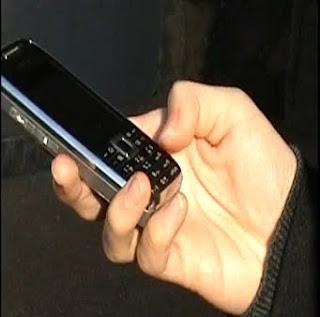 nager and our male character's identity and story wou
nager and our male character's identity and story wou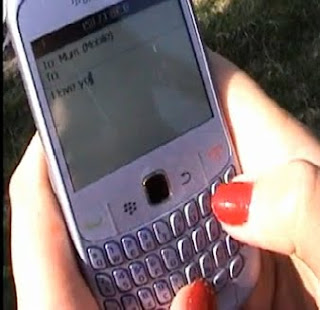 ld continue to be more known to the audience throughout the film; the audience may feel they can relate to the characters. Also our characters have been represented in a modern way by the use of modern technology like the phones and by the characters' clothes.
ld continue to be more known to the audience throughout the film; the audience may feel they can relate to the characters. Also our characters have been represented in a modern way by the use of modern technology like the phones and by the characters' clothes.
• What kind of media institution might distribute your media product and why?
A distribution company like Overture films would be ideal for the distribution of our thriller as
 they have distributed a thriller like Law Abiding Citizen (2009) which had a budget of $40.000.000 and the gross box office takings stood at $73,343,413 (USA). Another company that could also distribute our film is Warner Bros. Pictures. A thriller this company has distributed is Sherlock Holmes (2009) which had a budget of $90,000,000 and the gross box office takings of this film was $208,897,390 (USA). Either one of these would be ideal because they both have distributed successful thrillers which fits the genre of our media product.
they have distributed a thriller like Law Abiding Citizen (2009) which had a budget of $40.000.000 and the gross box office takings stood at $73,343,413 (USA). Another company that could also distribute our film is Warner Bros. Pictures. A thriller this company has distributed is Sherlock Holmes (2009) which had a budget of $90,000,000 and the gross box office takings of this film was $208,897,390 (USA). Either one of these would be ideal because they both have distributed successful thrillers which fits the genre of our media product.

Another distribution method could be by use of the internet. The internet has got resources that allow the world to view videos and films such as The Blair Witch Project (1999) and Paranormal Activity (2007). These are examples of two sucessful, low budget films who have been recognised and distributed through the internet and then later distributed into cinemas and DVDs.
• Who would be the audience for your media product?
Our chosen audience would be 16 year olds and up who are interested in thriller movies. This is shown as we have the use of young characters and a modern day setting. This audience chosen is also because we would want our film to have a mass audience.
• How did you attract/address your audience?
We attracted our audience by the use of tension and mystery within the introduction made. In order to engage narrative enigma we have a mysterious plot occurring within this opening sequence; the audience would not know why she is attempting suicide; they wouldn’t know why she is up on the cliff until she gets the phone call and the male character says ‘do not jump’ and then they would put two and two together with the text rto her mum at the start and what character B says. Also they wouldn’t know who the mystery man is and why he is stopping her. The tension is built up in a sense by not knowing whether the female character would jump or not. This would all in turn make the audience more interested in finding out who they are and what is going on and what is going to happen. Aside from the plot, sympathy and drama is also used to address the audience. The music used for when the female character is on the cliff is called ‘Abandoned’ which relates to her. It is moving and has a slow tempo and the use of orchestral instruments like; the violin, piano and the cello create a melancholic atmosphere. The piano comes in when she is looking at the picture of her and her best friends; this creates the sympathy for the character as you can tell she is upset.
• What have you learnt about technologies from the process of constructing this product?
• Looking back at your preliminary task, what do you feel you have learnt in the progression from it to the full product?
When doing the preliminary task I feel, in comparison to now, that I had basic knowledge about filming and editing and the skills involved. In this task we had to include a match-on-action shot, the 180° rule and a shot-reverse-shot and a basic conversation between two characters; this is limited compared to what we have done in our full product. This is also because the preliminary task was much shorter, required less than the full product and we had a shorter time to do it in so therefore further skills couldn’t be explored while doing that task. Now, after doing this product, I feel my skills have developed and I have gained more insight into the ways cameras and editing can be used. When doing this task and making our own opening sequence I got to try out different camera angles, shots and movements like pans; tracking shots; many match-on-action shots; close ups; mid-shots; long shots; over the shoulder shots; extreme close ups; establishing shots and zooms and when editing I could see which of these shots flowed better when putting it all together by using different transitions. In this task audio had to be used in order to create a mood and atmosphere for the opening sequence. To do this we recorded digetic and non-digetic sounds and ambient sounds like footsteps, cars, and birds. Also when recording the phone ringing, we layered a separate audio over the footage and dipped the sound when the character was away from the phone and made it louder as she got closer to it. I definitely have expanded my skills in editing while doing this product as I can use different video and audio effects and transitions now; I can layer different parts of sound and audio over others and also change the way the footage looks by means of using lighting effects and fades/dips and other tools too.
The media product that we have produced both follows and challenges the typical conventions of a thriller movie. One that it challenges is the lighting that is typically used w ithin thrillers; it is usually dark and gloomy to give a sinister effect whereas our product was filmed in bright daylight with no others present so it gives the effect of it being extremely early in the morning. One that it follows is that the victim or troubled one is a female character; our female character is easy to identify as she is young, pretty and fashonable like that of the female in Mullholland Drive (2001). Other thriller genre conventions that our product follows are; tension is built up; atmospheric music is used; mystery is apparent and narrative enigma is used throughout. We have done this by use of the male character’s mystery and the plot of the attempted suicide based around our main female character. Another convention we have followed is the use of atmospheric and dramatic music; we used an orchestral piece of music called 'Abandoned' it is dramatic and adds the moody atmosphere that we wanted to portray.
ithin thrillers; it is usually dark and gloomy to give a sinister effect whereas our product was filmed in bright daylight with no others present so it gives the effect of it being extremely early in the morning. One that it follows is that the victim or troubled one is a female character; our female character is easy to identify as she is young, pretty and fashonable like that of the female in Mullholland Drive (2001). Other thriller genre conventions that our product follows are; tension is built up; atmospheric music is used; mystery is apparent and narrative enigma is used throughout. We have done this by use of the male character’s mystery and the plot of the attempted suicide based around our main female character. Another convention we have followed is the use of atmospheric and dramatic music; we used an orchestral piece of music called 'Abandoned' it is dramatic and adds the moody atmosphere that we wanted to portray.
 ithin thrillers; it is usually dark and gloomy to give a sinister effect whereas our product was filmed in bright daylight with no others present so it gives the effect of it being extremely early in the morning. One that it follows is that the victim or troubled one is a female character; our female character is easy to identify as she is young, pretty and fashonable like that of the female in Mullholland Drive (2001). Other thriller genre conventions that our product follows are; tension is built up; atmospheric music is used; mystery is apparent and narrative enigma is used throughout. We have done this by use of the male character’s mystery and the plot of the attempted suicide based around our main female character. Another convention we have followed is the use of atmospheric and dramatic music; we used an orchestral piece of music called 'Abandoned' it is dramatic and adds the moody atmosphere that we wanted to portray.
ithin thrillers; it is usually dark and gloomy to give a sinister effect whereas our product was filmed in bright daylight with no others present so it gives the effect of it being extremely early in the morning. One that it follows is that the victim or troubled one is a female character; our female character is easy to identify as she is young, pretty and fashonable like that of the female in Mullholland Drive (2001). Other thriller genre conventions that our product follows are; tension is built up; atmospheric music is used; mystery is apparent and narrative enigma is used throughout. We have done this by use of the male character’s mystery and the plot of the attempted suicide based around our main female character. Another convention we have followed is the use of atmospheric and dramatic music; we used an orchestral piece of music called 'Abandoned' it is dramatic and adds the moody atmosphere that we wanted to portray.• How does your media product represent particular social groups?
In our media product that is our opening sequence of a thriller movie we have an 18 year old girl who is troubled and is contemplating suicide, played by our chosen actress Annie Nurse. This character looks that of upper middle class as she doesn’t look overdone and doesn’t look what the majority would perceive as rich or poor. We also have a mystery man played by our chosen actor Jonathan Tang. He has a hidden identity at this point in the film and we are not supposed to know who he really is at the start of the film. He looks sinister as he is dressed in dark clothes and you do not see his full face. These characters are both protagonists and are represented as this because the male character does a good deed in stopping the girl’s suicide whereas the girl looks like the victim as she seems troubled. If developed further we would see how how female character would be represented as a troubled tee nager and our male character's identity and story wou
nager and our male character's identity and story wou ld continue to be more known to the audience throughout the film; the audience may feel they can relate to the characters. Also our characters have been represented in a modern way by the use of modern technology like the phones and by the characters' clothes.
ld continue to be more known to the audience throughout the film; the audience may feel they can relate to the characters. Also our characters have been represented in a modern way by the use of modern technology like the phones and by the characters' clothes.• What kind of media institution might distribute your media product and why?
A distribution company like Overture films would be ideal for the distribution of our thriller as

 they have distributed a thriller like Law Abiding Citizen (2009) which had a budget of $40.000.000 and the gross box office takings stood at $73,343,413 (USA). Another company that could also distribute our film is Warner Bros. Pictures. A thriller this company has distributed is Sherlock Holmes (2009) which had a budget of $90,000,000 and the gross box office takings of this film was $208,897,390 (USA). Either one of these would be ideal because they both have distributed successful thrillers which fits the genre of our media product.
they have distributed a thriller like Law Abiding Citizen (2009) which had a budget of $40.000.000 and the gross box office takings stood at $73,343,413 (USA). Another company that could also distribute our film is Warner Bros. Pictures. A thriller this company has distributed is Sherlock Holmes (2009) which had a budget of $90,000,000 and the gross box office takings of this film was $208,897,390 (USA). Either one of these would be ideal because they both have distributed successful thrillers which fits the genre of our media product.

Another distribution method could be by use of the internet. The internet has got resources that allow the world to view videos and films such as The Blair Witch Project (1999) and Paranormal Activity (2007). These are examples of two sucessful, low budget films who have been recognised and distributed through the internet and then later distributed into cinemas and DVDs.
• Who would be the audience for your media product?
Our chosen audience would be 16 year olds and up who are interested in thriller movies. This is shown as we have the use of young characters and a modern day setting. This audience chosen is also because we would want our film to have a mass audience.
• How did you attract/address your audience?
We attracted our audience by the use of tension and mystery within the introduction made. In order to engage narrative enigma we have a mysterious plot occurring within this opening sequence; the audience would not know why she is attempting suicide; they wouldn’t know why she is up on the cliff until she gets the phone call and the male character says ‘do not jump’ and then they would put two and two together with the text rto her mum at the start and what character B says. Also they wouldn’t know who the mystery man is and why he is stopping her. The tension is built up in a sense by not knowing whether the female character would jump or not. This would all in turn make the audience more interested in finding out who they are and what is going on and what is going to happen. Aside from the plot, sympathy and drama is also used to address the audience. The music used for when the female character is on the cliff is called ‘Abandoned’ which relates to her. It is moving and has a slow tempo and the use of orchestral instruments like; the violin, piano and the cello create a melancholic atmosphere. The piano comes in when she is looking at the picture of her and her best friends; this creates the sympathy for the character as you can tell she is upset.
• What have you learnt about technologies from the process of constructing this product?
During the construction of this product I have learnt many technological things like using the camera effectively; sorting out white balance; using different settings; using it on the tripod when doing shots in order to make them steady and run smoothly when doing a pan or a tracking shot. I also have learnt how to use the editing software to a better extent. We use Adobe Premiere Pro for editing so as the making of the product has gone on I have been able to learn more things and find more uses for the software such as the effect controls, fitting different clips together and layering them with extra footage and audio.


• Looking back at your preliminary task, what do you feel you have learnt in the progression from it to the full product?
When doing the preliminary task I feel, in comparison to now, that I had basic knowledge about filming and editing and the skills involved. In this task we had to include a match-on-action shot, the 180° rule and a shot-reverse-shot and a basic conversation between two characters; this is limited compared to what we have done in our full product. This is also because the preliminary task was much shorter, required less than the full product and we had a shorter time to do it in so therefore further skills couldn’t be explored while doing that task. Now, after doing this product, I feel my skills have developed and I have gained more insight into the ways cameras and editing can be used. When doing this task and making our own opening sequence I got to try out different camera angles, shots and movements like pans; tracking shots; many match-on-action shots; close ups; mid-shots; long shots; over the shoulder shots; extreme close ups; establishing shots and zooms and when editing I could see which of these shots flowed better when putting it all together by using different transitions. In this task audio had to be used in order to create a mood and atmosphere for the opening sequence. To do this we recorded digetic and non-digetic sounds and ambient sounds like footsteps, cars, and birds. Also when recording the phone ringing, we layered a separate audio over the footage and dipped the sound when the character was away from the phone and made it louder as she got closer to it. I definitely have expanded my skills in editing while doing this product as I can use different video and audio effects and transitions now; I can layer different parts of sound and audio over others and also change the way the footage looks by means of using lighting effects and fades/dips and other tools too.
Friday, 19 March 2010
Thriller Opening Sequence - 'Absent' 1st draft.
The 1st draft of our thriller opening sequence was in for today and we had completed this task 3 days prior to this deadline.
(The video above is our first draft)
When Henna and I were importing the video to YouTube the file was corrupted and the picture was distorted, pixelated and off colour; Henna and I repeated uploading the file plenty of times to Youtube, but the same thing happened. For the next lesson Henna and I decided to reconvert the video and upload that new file onto Youtube as we figured something had gone wrong with the first file convert.
* Because this happened this post had been edited in the next lesson in order to embed the video from Youtube into my blog.
Overall I feel that our opening sequence fits into the chosen genre of a thriller as we have created a sense of tension, mystery and narrative enigma in order to keep ur audience hooked. I also think that our characters fit their chosen roles and play them well. Though I think a few parts need to be shortened and when Character B says 'Don't Jump', it needs to be clearer so a possible re-film maybe needed there.
Thursday, 18 March 2010
Editing the 1st Draft.
*Throughout the whole editing process, I physically did the editing on the computer while Henna, Trisha and myself directed the editing apart from twice when Henna did some editing on the computer. All editing decisions came from us all as a group.
(04/03/10)Lesson 1: Today we were able to start editing the footage that we had previously filmed on Tuesday, but first we had to capture the footage onto the computer by using the capture feature on Adobe Premiere Pro CS4. When capturing we realised that the computer wasn't capturing the image very well from the tape; it was appearing distorted and when played back on the camera it actually wasn't. We attempted this a couple more times but it still wasn't working so we decided to capture the footage by connecting the camera directly to the computer with the tape in it. Although this took much longer, this technique proved better for us and we were able to save our footage onto our 'T':Drive.
Before editing our footage, we noticed there were over 50 clips saved which contained the footage we needed and also some shots we had repeated because we needed to make sure we got it right or because some went wrong; this needed sorting out so we went through them one by one deleting ones we don't need and keeping ones we do need in our project file on Adobe Premiere Pro CS4.
After doing this we renamed our clips so it would be easier to tell them apart during the editing process instead of trying to tell them apart with names like 'Untitled Clip 001'. After doing this the programme crashed and we found that the auto-save feature was not working so by the end we had renamed all of the clips again.
(09/03/10)Lesson 2: Today we carried on with the editing process and we started the lesson by reffering back to our storyboard so we knew what clip we should put first. We figured it was the establishing shot so we put it on the editing timeline and watched it back. The sound was excellent and the zoom out we had worked well, but we all thought it was too long. We trimmed the clip and watched it through again. It was about 15secs. shorter than the original and this made it more effective for the audience to know the surroundings of this place and how high up it is and less dragged out.
The next clip that we edited was the walking feet of character A. In the original clip we had planned for the shot to pan up from her feet to her face, this couldn't happen as something was in the background of the shot, when moved up to her face, that we didn't want so we decided to just keep her walking feet and we trimmed the clip to where we thought was best.
The next clip we edited was an over the shoulder mid shot. On this clip we saw that the sun light had made the clip look too bright in contrast to the others clips, but by adjusting the colour we overcame this problem. We went through a lot of the following clips and watched them, trimmed them down to where we wanted and adjusted bits of audio.
All three of us in our group wanted our opening sequence to be the best it could so sometimes we'd disagree on the clips, but would offer our ideas of how to improve.
(11/03/10)Lesson 3: Today we focussed on one clip in particular; the clip of the phone being zoomed in on when it is ringing. This clip took a lot of time to edit because when filmed we had a loose shoe on our tripod so when attempting the zoom in the shot was sometimes unsteady. We had all filmed this many times and we only found a good few shots of the phone where we could clearly see the words 'incoming call' and 'unknown number' on the screen so we trimmed them down, put different shots together and layered the same audio over the top of each clip so it would sound like it was originally in the same clip and after trying out different arrangements of the clips we found the one that worked as we wanted. Then we were about to move onto the next clip and try to find some music to go onto the soundtrack of our opening sequence but then our software, Adobe Premier Pro CS4, crashed. This caused us to lose to lose half of the editing we had done as the auto-save feature was not working again. We then discussed what we should do and then decided that I would do the editing all over again while Henna and Trisha discuss the music for our soundtrack. After this was done they discussed with me what they had thought about for the soundtrack, they said they felt we did not need any more ambient sound and we all agreed on finding copyright free music that was dramatic and somewhat orchestral.
(16/03/10)Lesson 4: Today we edited the last few clips which contained Character B’s walking and speaking part and Character A’s speaking part along with her walking over to the ringing phone, dropping the phone and running away. We trimmed these down and added and adjusted appropriate background noise to make it all flow for example the phone ringing; I put the same audio used when the phone is ringing at first over every other clip the phone is ringing in, then dipped the volume when she is further away from the phone and raised it when she was nearer by it. After doing this we moved onto the title sequence. The software was being slightly slower than normal but after noticing this we saved our project every five minutes because it had crashed before and we did not want this happening again.
ringing; I put the same audio used when the phone is ringing at first over every other clip the phone is ringing in, then dipped the volume when she is further away from the phone and raised it when she was nearer by it. After doing this we moved onto the title sequence. The software was being slightly slower than normal but after noticing this we saved our project every five minutes because it had crashed before and we did not want this happening again.
When doing the title sequence we all agreed on the font and their whereabouts and the fade transitions. This did not take too long so then we started to play around with the scene transitions at the start of our sequence. We tried out different transitions but the cross transition made them fade into each other. We did this with the first scenes of Character A up until Character B walking.
(18/03/10)Lesson 5: Today we wanted to sort out the soundtrack of our opening sequence. We all looked on different music websites that offered copyright free music. We wanted something slow paced, dramatic and atmospheric to fit our theme of a genre. Trisha and I found a piece of music on the website: http://freeplaymusic.com called 'Abandoned'. We thought the title fit our character and also the music was dramatic, orchestral and fairly slow paced. We downloaded the track and then imported it onto Adobe Premier Pro CS4. The starting to the music piece suited the opening sequence so I trimmed the track down and placed it where we wanted it. We felt this created the mood and atmosphere we wanted and was perfect for our opening sequence.
(04/03/10)Lesson 1: Today we were able to start editing the footage that we had previously filmed on Tuesday, but first we had to capture the footage onto the computer by using the capture feature on Adobe Premiere Pro CS4. When capturing we realised that the computer wasn't capturing the image very well from the tape; it was appearing distorted and when played back on the camera it actually wasn't. We attempted this a couple more times but it still wasn't working so we decided to capture the footage by connecting the camera directly to the computer with the tape in it. Although this took much longer, this technique proved better for us and we were able to save our footage onto our 'T':Drive.
Before editing our footage, we noticed there were over 50 clips saved which contained the footage we needed and also some shots we had repeated because we needed to make sure we got it right or because some went wrong; this needed sorting out so we went through them one by one deleting ones we don't need and keeping ones we do need in our project file on Adobe Premiere Pro CS4.
After doing this we renamed our clips so it would be easier to tell them apart during the editing process instead of trying to tell them apart with names like 'Untitled Clip 001'. After doing this the programme crashed and we found that the auto-save feature was not working so by the end we had renamed all of the clips again.
(09/03/10)Lesson 2: Today we carried on with the editing process and we started the lesson by reffering back to our storyboard so we knew what clip we should put first. We figured it was the establishing shot so we put it on the editing timeline and watched it back. The sound was excellent and the zoom out we had worked well, but we all thought it was too long. We trimmed the clip and watched it through again. It was about 15secs. shorter than the original and this made it more effective for the audience to know the surroundings of this place and how high up it is and less dragged out.
The next clip that we edited was the walking feet of character A. In the original clip we had planned for the shot to pan up from her feet to her face, this couldn't happen as something was in the background of the shot, when moved up to her face, that we didn't want so we decided to just keep her walking feet and we trimmed the clip to where we thought was best.
The next clip we edited was an over the shoulder mid shot. On this clip we saw that the sun light had made the clip look too bright in contrast to the others clips, but by adjusting the colour we overcame this problem. We went through a lot of the following clips and watched them, trimmed them down to where we wanted and adjusted bits of audio.
All three of us in our group wanted our opening sequence to be the best it could so sometimes we'd disagree on the clips, but would offer our ideas of how to improve.
(11/03/10)Lesson 3: Today we focussed on one clip in particular; the clip of the phone being zoomed in on when it is ringing. This clip took a lot of time to edit because when filmed we had a loose shoe on our tripod so when attempting the zoom in the shot was sometimes unsteady. We had all filmed this many times and we only found a good few shots of the phone where we could clearly see the words 'incoming call' and 'unknown number' on the screen so we trimmed them down, put different shots together and layered the same audio over the top of each clip so it would sound like it was originally in the same clip and after trying out different arrangements of the clips we found the one that worked as we wanted. Then we were about to move onto the next clip and try to find some music to go onto the soundtrack of our opening sequence but then our software, Adobe Premier Pro CS4, crashed. This caused us to lose to lose half of the editing we had done as the auto-save feature was not working again. We then discussed what we should do and then decided that I would do the editing all over again while Henna and Trisha discuss the music for our soundtrack. After this was done they discussed with me what they had thought about for the soundtrack, they said they felt we did not need any more ambient sound and we all agreed on finding copyright free music that was dramatic and somewhat orchestral.
(16/03/10)Lesson 4: Today we edited the last few clips which contained Character B’s walking and speaking part and Character A’s speaking part along with her walking over to the ringing phone, dropping the phone and running away. We trimmed these down and added and adjusted appropriate background noise to make it all flow for example the phone
 ringing; I put the same audio used when the phone is ringing at first over every other clip the phone is ringing in, then dipped the volume when she is further away from the phone and raised it when she was nearer by it. After doing this we moved onto the title sequence. The software was being slightly slower than normal but after noticing this we saved our project every five minutes because it had crashed before and we did not want this happening again.
ringing; I put the same audio used when the phone is ringing at first over every other clip the phone is ringing in, then dipped the volume when she is further away from the phone and raised it when she was nearer by it. After doing this we moved onto the title sequence. The software was being slightly slower than normal but after noticing this we saved our project every five minutes because it had crashed before and we did not want this happening again.When doing the title sequence we all agreed on the font and their whereabouts and the fade transitions. This did not take too long so then we started to play around with the scene transitions at the start of our sequence. We tried out different transitions but the cross transition made them fade into each other. We did this with the first scenes of Character A up until Character B walking.
(18/03/10)Lesson 5: Today we wanted to sort out the soundtrack of our opening sequence. We all looked on different music websites that offered copyright free music. We wanted something slow paced, dramatic and atmospheric to fit our theme of a genre. Trisha and I found a piece of music on the website: http://freeplaymusic.com called 'Abandoned'. We thought the title fit our character and also the music was dramatic, orchestral and fairly slow paced. We downloaded the track and then imported it onto Adobe Premier Pro CS4. The starting to the music piece suited the opening sequence so I trimmed the track down and placed it where we wanted it. We felt this created the mood and atmosphere we wanted and was perfect for our opening sequence.
Tuesday, 2 March 2010
Filming.
Today my group, our chosen actors and I decided to film our opening sequence. We used a Sony Camera with a tape and a tripod. We did not need any extra lighting as it was quite a bright day and we wanted natural light.
We set off at around 10am with one of our actors, Annie. We walked to one of the chosen locations which was the clifftop. We started with the establishing shot of the clifftop view which would set the scene in our opening sequence. We had to re-film this a few times over just so we got it right.
I attempted one of the establishing shots and shot the shots of Annie picking up the phone; the close up of her talking on the phone; the shot of her running away which i had to film a few times over and also the close up of the phone for the end of our opening sequence. Each of us within the group took turns to film, direct and make sure that everything else is okay when filming the shots.
When filming, we noticed that the shoe on the tripod was a bit stiff when panning the camera from left or right, or up or down. We overcame this by changing the tripod; in order to do this, a trip back to the college was required. This was convienient as we finished filming our first set of shots at around 12 so then we needed to get Jonathan from college so we could film the next set.
After gathering a different tripod and the extra props and our actor, Jonathan Tang, we went back to the location of the clifftop to continue filming the rest of Annie's scenes. But just before this, Patricia and I took a detour and went to the bottom of the cliff and told Henna, Jonathan and Annie to go to the top and that we would meet them there. We took the camera with us and told Annie to stand at the top so we could zoom in on her from the bottom of the cliff. We thought this would be effective as then it would give a feel of the height of the cliff and how much serious danger our character could be in. Patricia and I took turns filming this many times to get it right.
When we joined them back at the top of the cliff, Henna filmed Annie taking the photo out of her pocket and then I filmed Annie looking at the photo at a high angle, looking over her shoulder. As Jonathan was also with us we started filming his shots which took place in our second location choice of the graveyard, which was around 5 minutes away from the cliff edge. Henna filmed the long shot of Jonathan walking through the graveyard and close up of him dialing the number on the phone. I filmed the long shot of Jonathan on the phone and the close up of him talking on the phone which took several attempts because we needed a clear sound. This was the end of filming our opening sequence and we had finished at around 3pm.
One of the main problems we encountered was the lighting, as the weather was cold and the sun was out, it was casting unnecessary shadows and also making the scenery look too bright and in some shots was causing the actor and us to not be able to see properly due to the sunlight. The white balance on the camera didn't help with the brightness as when reset it did not take it away.
We set off at around 10am with one of our actors, Annie. We walked to one of the chosen locations which was the clifftop. We started with the establishing shot of the clifftop view which would set the scene in our opening sequence. We had to re-film this a few times over just so we got it right.
I attempted one of the establishing shots and shot the shots of Annie picking up the phone; the close up of her talking on the phone; the shot of her running away which i had to film a few times over and also the close up of the phone for the end of our opening sequence. Each of us within the group took turns to film, direct and make sure that everything else is okay when filming the shots.
When filming, we noticed that the shoe on the tripod was a bit stiff when panning the camera from left or right, or up or down. We overcame this by changing the tripod; in order to do this, a trip back to the college was required. This was convienient as we finished filming our first set of shots at around 12 so then we needed to get Jonathan from college so we could film the next set.
After gathering a different tripod and the extra props and our actor, Jonathan Tang, we went back to the location of the clifftop to continue filming the rest of Annie's scenes. But just before this, Patricia and I took a detour and went to the bottom of the cliff and told Henna, Jonathan and Annie to go to the top and that we would meet them there. We took the camera with us and told Annie to stand at the top so we could zoom in on her from the bottom of the cliff. We thought this would be effective as then it would give a feel of the height of the cliff and how much serious danger our character could be in. Patricia and I took turns filming this many times to get it right.
When we joined them back at the top of the cliff, Henna filmed Annie taking the photo out of her pocket and then I filmed Annie looking at the photo at a high angle, looking over her shoulder. As Jonathan was also with us we started filming his shots which took place in our second location choice of the graveyard, which was around 5 minutes away from the cliff edge. Henna filmed the long shot of Jonathan walking through the graveyard and close up of him dialing the number on the phone. I filmed the long shot of Jonathan on the phone and the close up of him talking on the phone which took several attempts because we needed a clear sound. This was the end of filming our opening sequence and we had finished at around 3pm.
One of the main problems we encountered was the lighting, as the weather was cold and the sun was out, it was casting unnecessary shadows and also making the scenery look too bright and in some shots was causing the actor and us to not be able to see properly due to the sunlight. The white balance on the camera didn't help with the brightness as when reset it did not take it away.
Saturday, 27 February 2010
Friday, 26 February 2010
Actors
As a group we have discussed what actors we needed and who would be suitable for the role. We decided to use Annie Nurse as the young girl (character a) and Jonathan Tang as the mystery man (character b) in our opening thriller sequence.
Annie is suitable for this role because she is 16 years old but does look older so can look the same age as the girl who would be 18. She suits the expected appearance and can portray the body language that is needed. Although she has not much previous acting experience she can relate to the emotion of the the character as Annie is just a typical teenager. As she is a close friend of ours we know that she will reliable and will act according.
Jonathan is suitable for this role because he looks older so can be identified as the older mystery man. He can look mystifying which would be good and would live up to his role. He also has not much previous acting experience but I am sure that he will as best he can. As he is a close friend of ours we know that he will be reliable and will act to the role as best he can.
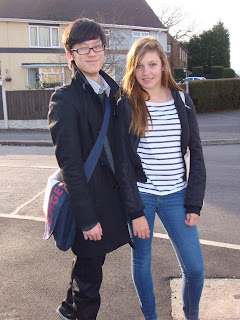
(Jonathan: left, Annie: right)
Annie is suitable for this role because she is 16 years old but does look older so can look the same age as the girl who would be 18. She suits the expected appearance and can portray the body language that is needed. Although she has not much previous acting experience she can relate to the emotion of the the character as Annie is just a typical teenager. As she is a close friend of ours we know that she will reliable and will act according.
Jonathan is suitable for this role because he looks older so can be identified as the older mystery man. He can look mystifying which would be good and would live up to his role. He also has not much previous acting experience but I am sure that he will as best he can. As he is a close friend of ours we know that he will be reliable and will act to the role as best he can.

(Jonathan: left, Annie: right)
Wednesday, 24 February 2010
Locations.
Patricia was assigned to the task of location in our group and this is what she did:
Since our story is based around a girl jumping off a cliff we knew that whereever we were going to film there was going to have to be a cliff there. We discussed about various locations we could film at but we then we decided that some of the locations would take too long to get too or were too difficult to get too.
In the end we decided on filming at a place called 'Bobs Rock'.
This is the perfect location as it has wooded area and also a cliff which is vital as this is where most of our filming is going to place. There is also a graveyard where we could also film to help add to the spooky atmosphere which we are trying to capture.
'Bob's Rock.'
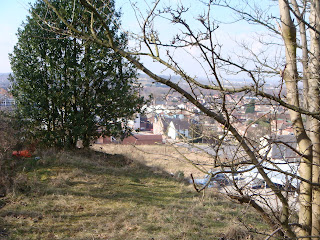
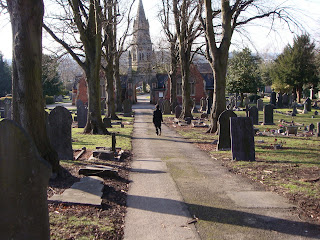
The Graveyard.
Since our story is based around a girl jumping off a cliff we knew that whereever we were going to film there was going to have to be a cliff there. We discussed about various locations we could film at but we then we decided that some of the locations would take too long to get too or were too difficult to get too.
In the end we decided on filming at a place called 'Bobs Rock'.
This is the perfect location as it has wooded area and also a cliff which is vital as this is where most of our filming is going to place. There is also a graveyard where we could also film to help add to the spooky atmosphere which we are trying to capture.
'Bob's Rock.'


The Graveyard.
Tuesday, 23 February 2010
Thriller Task - Props
Henna Mistry was assigned to the task of props in our group and this is what she did:
In the opening sequence to the thriller that we are producing, props need to used or the opening sequence would be dry and boring and in place would not make sense. The props that may be used are:
A mobile phone:

The phone will be the main prop used in the thriller, as this prop will set the scene at the beginning of the opening sequence. As the audience will see the phone on the chosen location which will create the suspense. The main character will be seen answering the phone to a mysterious character. It will be used because a phone is modern technology which is used in everyday life to communicate with others.
A photo:
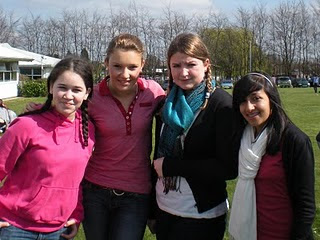
The photo will be of the main character and her friends, she will be looking happy and having a good time. She will be holding looking at the photo but will look sad, which again the audience will start to ask questions and become interested. This will make more sense as the opening sequence progresses of why the character is upset. We thought this would be suitable as being a teenager means having a good time when with your friends and taking photos to keep the memories.
In the opening sequence to the thriller that we are producing, props need to used or the opening sequence would be dry and boring and in place would not make sense. The props that may be used are:
A mobile phone:

The phone will be the main prop used in the thriller, as this prop will set the scene at the beginning of the opening sequence. As the audience will see the phone on the chosen location which will create the suspense. The main character will be seen answering the phone to a mysterious character. It will be used because a phone is modern technology which is used in everyday life to communicate with others.
A photo:

The photo will be of the main character and her friends, she will be looking happy and having a good time. She will be holding looking at the photo but will look sad, which again the audience will start to ask questions and become interested. This will make more sense as the opening sequence progresses of why the character is upset. We thought this would be suitable as being a teenager means having a good time when with your friends and taking photos to keep the memories.
Thriller Task - Risk Assessment
As a group we all completed a risk assessment together to assess the risks and how to prevent them from happening when filming.
Risk: Cliff top
Reason: This is a risk because there is a chance of someone falling off this cliff and getting seriously injured as the cliff is quite high.
Prevention: The group can overcome this by acting sensibly and not going to close to the edge of the cliff. Also filming on stable land which is not to close to the edge.
Risk: Damage of equipment
Reason: This is a risk because if the equipment became damaged or broken, it is our responsibility we will have to pay to replace it, which could cost a lot.
Prevention: We can overcome this by acting logically, but using it to the best of our ability, keeping the equipment with us at all time and not leaving it unattended.
Risk: Weather
Reason: This is because it could ruin the eerie tense atmosphere that we are tyring to create with the opening sequence. It could also damage the camera equipment. If it snows or becomes icy it may be difficult to even reach our location.
Prevention: This can be prevented by keeping the equipment in cases and avoid filming in bad weather conditions. We could also check the weather forecast the day before we are going to film to make sure the weather isn't bad.
Risk: Other people
Reason: This is a risk because if wandering people may disturb the shot while we are filming, they may also get in the way of the shot and ruin the tense atmosphere that we are trying to create.
Prevention: This can be prevented by filming in a quiet location of where we are filming, so that not many people will be there to disturb when filming.
Risk: Damage of Props
Reason: This is a risk because if a prop is dropped it may become damaged and broken, this again is our responsibility. If the item belongs to someone else we need to take extra care.Prevention: This can be overcome by keeping an eye on the props at all time and using them carefully when in use.
Risk: Damage to Crew and Cast
Reason: This is a risk because there are nettles and bushes that can be harmful if they are dangerous. The land could be uneven and there could be rock causing an accident to the cast or crew while filming and acting.
Prevention: This can be overcome by acting carefully and being aware of the surroundings around the location.
Risk: Cliff top
Reason: This is a risk because there is a chance of someone falling off this cliff and getting seriously injured as the cliff is quite high.
Prevention: The group can overcome this by acting sensibly and not going to close to the edge of the cliff. Also filming on stable land which is not to close to the edge.
Risk: Damage of equipment
Reason: This is a risk because if the equipment became damaged or broken, it is our responsibility we will have to pay to replace it, which could cost a lot.
Prevention: We can overcome this by acting logically, but using it to the best of our ability, keeping the equipment with us at all time and not leaving it unattended.
Risk: Weather
Reason: This is because it could ruin the eerie tense atmosphere that we are tyring to create with the opening sequence. It could also damage the camera equipment. If it snows or becomes icy it may be difficult to even reach our location.
Prevention: This can be prevented by keeping the equipment in cases and avoid filming in bad weather conditions. We could also check the weather forecast the day before we are going to film to make sure the weather isn't bad.
Risk: Other people
Reason: This is a risk because if wandering people may disturb the shot while we are filming, they may also get in the way of the shot and ruin the tense atmosphere that we are trying to create.
Prevention: This can be prevented by filming in a quiet location of where we are filming, so that not many people will be there to disturb when filming.
Risk: Damage of Props
Reason: This is a risk because if a prop is dropped it may become damaged and broken, this again is our responsibility. If the item belongs to someone else we need to take extra care.Prevention: This can be overcome by keeping an eye on the props at all time and using them carefully when in use.
Risk: Damage to Crew and Cast
Reason: This is a risk because there are nettles and bushes that can be harmful if they are dangerous. The land could be uneven and there could be rock causing an accident to the cast or crew while filming and acting.
Prevention: This can be overcome by acting carefully and being aware of the surroundings around the location.
Monday, 22 February 2010
Questionnaire.
Patricia, Henna and I carried out a questionnaire in order to find out what our target audience of teenagers (16-18 years old) want to see in Thriller movies. We carried out this questionnaire on 18 students, although this gives a very biased sample of the audience as it is a very limited sample. Therefore results cannot be generalised across our whole target audience of teenagers.
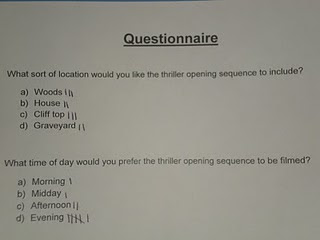
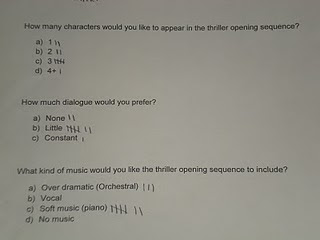




Saturday, 13 February 2010
The Thriller Film Industry.
I began my research on the Internet Movie Database (IMDB)(http://www.imdb.com/genre/thriller) by looking at films by genre and going into the thriller section. The IMDB is the largest internet based database for information on directors, actors, celebrity stories, films and reviews. This website gave me the the current most popular thrillers which are:
1.The Wolfman
 Dir: Joe Johnston, Genre: Horror | Thriller
Dir: Joe Johnston, Genre: Horror | Thriller
2. Edge of Darkness
 Dir: Martin Campbell, Genre: Drama | Thriller
Dir: Martin Campbell, Genre: Drama | Thriller
3. From Paris With Love
 Dir: Pierre Morel, Genre: Action | Crime | Thriller
Dir: Pierre Morel, Genre: Action | Crime | Thriller
4. The Hurt Locker
 Dir: Kathryn Bigelow, Genre: Action | Drama | Thriller | War
Dir: Kathryn Bigelow, Genre: Action | Drama | Thriller | War
5. Shutter Island
 Dir: Martin Scorsese, Genre: Drama | Mystery | Thriller
Dir: Martin Scorsese, Genre: Drama | Mystery | Thriller
Three of these films, 'Wolfman', 'From Paris With Love' and 'Edge of Darkness', were also in the top 10 USA weekend Box Office Summary for this weekend, which shows the popularity of this genre.
From these films I can see that when there are thriller movies they are usually mixed with another genre in order to reflect their storylines. This could occur in our thriller, so after we have planned what our main story is, we may have to look at other genres to see if our film ties in with any others so we can avoid claiming it is a pure thriller as there don't seem to be any around without sub-genres.
According to www.movies.com.au 'The majority of thriller movies are actually hybrid films that use characteristics of another type of genre to maintain audience interest and anticipation', and the different hybrids are:
* Action thriller
* Conspiracy thriller
* Crime thriller
* Disaster thriller
* Drama thriller
* Eco-thriller
* Erotic thriller
* Legal thriller
* Medical thriller
* Political thriller
* Psychological thriller
* Spy thriller
* Techno-thriller
* Religious thriller
I also found a chart for the best and a chart for the worst Thriller films ever made, as voted for by IMDB users.(http://www.imdb.com/chart/thriller)
The 5 Top rated Thrillers of all time, according to the chart, are:
1. The Godfather (1972)
2. The Godfather: Part II (1974)
3. The Dark Knight (2008)
4. Rear Window (1954)
5. Fight Club (1999)
This chart shows how Thrillers have always been popular throughout the years and also shows how the genre has not been lost over time, as one of 5 these 'top thrillers' dates back to 1954, and another at 2008. The oldest movie on the chart called 'The Big Sleep' was made in 1946, and the most recent film on the chart is 'Inglourious Basterds' which was released in 2009.
Another website I used for research is http://www.toptenreviews.com. They keep up to date with movies, reviews, and the top directors and films and have plenty of information on their website.
According to their research, the top 10 thriller movie directors are:
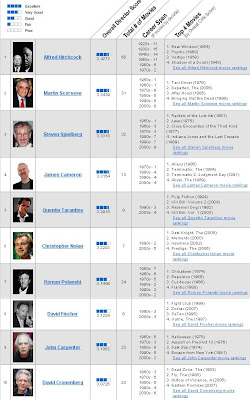
(click to make bigger)
1.The Wolfman
 Dir: Joe Johnston, Genre: Horror | Thriller
Dir: Joe Johnston, Genre: Horror | Thriller2. Edge of Darkness
 Dir: Martin Campbell, Genre: Drama | Thriller
Dir: Martin Campbell, Genre: Drama | Thriller3. From Paris With Love
 Dir: Pierre Morel, Genre: Action | Crime | Thriller
Dir: Pierre Morel, Genre: Action | Crime | Thriller4. The Hurt Locker
 Dir: Kathryn Bigelow, Genre: Action | Drama | Thriller | War
Dir: Kathryn Bigelow, Genre: Action | Drama | Thriller | War5. Shutter Island
 Dir: Martin Scorsese, Genre: Drama | Mystery | Thriller
Dir: Martin Scorsese, Genre: Drama | Mystery | ThrillerThree of these films, 'Wolfman', 'From Paris With Love' and 'Edge of Darkness', were also in the top 10 USA weekend Box Office Summary for this weekend, which shows the popularity of this genre.
From these films I can see that when there are thriller movies they are usually mixed with another genre in order to reflect their storylines. This could occur in our thriller, so after we have planned what our main story is, we may have to look at other genres to see if our film ties in with any others so we can avoid claiming it is a pure thriller as there don't seem to be any around without sub-genres.
According to www.movies.com.au 'The majority of thriller movies are actually hybrid films that use characteristics of another type of genre to maintain audience interest and anticipation', and the different hybrids are:
* Action thriller
* Conspiracy thriller
* Crime thriller
* Disaster thriller
* Drama thriller
* Eco-thriller
* Erotic thriller
* Legal thriller
* Medical thriller
* Political thriller
* Psychological thriller
* Spy thriller
* Techno-thriller
* Religious thriller
I also found a chart for the best and a chart for the worst Thriller films ever made, as voted for by IMDB users.(http://www.imdb.com/chart/thriller)
The 5 Top rated Thrillers of all time, according to the chart, are:
1. The Godfather (1972)
2. The Godfather: Part II (1974)
3. The Dark Knight (2008)
4. Rear Window (1954)
5. Fight Club (1999)
This chart shows how Thrillers have always been popular throughout the years and also shows how the genre has not been lost over time, as one of 5 these 'top thrillers' dates back to 1954, and another at 2008. The oldest movie on the chart called 'The Big Sleep' was made in 1946, and the most recent film on the chart is 'Inglourious Basterds' which was released in 2009.
Another website I used for research is http://www.toptenreviews.com. They keep up to date with movies, reviews, and the top directors and films and have plenty of information on their website.
According to their research, the top 10 thriller movie directors are:

(click to make bigger)
Costume
For the female character in our opening sequence, I thought that she could wear a stylish winter coat to represent her age and class, the season and the current climate. I thought she could wear this with jeans and a top and some flat shoes because it could depict her age.
For the male character in our opening sequence I wanted to create a serious, mysterious character so I thought a long black trench coat, white shirt, possibly a black tie, black trousers, a pair of black patent leather shoes and maybe a black hat. The tie, shirt and trousers represents the seriousness of the character and adds a sense of formality. I chose a long trench coat to add mystery and the hat also does this too and will cast a shadow over the characters face for this effect of a hidden identity, although we may not use the hat. The colours black and white are formal as well and do not give anything about the character's personality away.
For the male character in our opening sequence I wanted to create a serious, mysterious character so I thought a long black trench coat, white shirt, possibly a black tie, black trousers, a pair of black patent leather shoes and maybe a black hat. The tie, shirt and trousers represents the seriousness of the character and adds a sense of formality. I chose a long trench coat to add mystery and the hat also does this too and will cast a shadow over the characters face for this effect of a hidden identity, although we may not use the hat. The colours black and white are formal as well and do not give anything about the character's personality away.
Friday, 12 February 2010
The Bourne Identity (2002) - Opening Sequence.
I watched and analysed the first 3 minutes of this film on DVD.
Camera:
Editing:
Camera:
- One camera movement I thought was effective was the first one in the opening sequence; the camera zooms in on a character in the water and it looks like a floating dead body. This fits with the genre of a thriller because it follows the conventions of narrative enigma; the audience wouldn't know it's the main character at first in the water, and they would question whether that character is dead or not and if so who did it or what happened would also be questions raised. Another convention this follows is that a possible crime may have been committed.
- The close up of the scalpel cutting into the character's wetsuit makes it look as though it is cutting his skin until it shows the man peeling back the wetsuit. This raises narrative enigma until that point.
- In the first 30 secs of the film there is the sound of thunder, this is effective as it sets a estranged atmosphere and a dark, gloomy mood, all of which is typical of the thriller genre.
- The soundtrack on this opening scene is dark and starts off slow paced but then gets slightly faster pace. It is orchestral, dramatic and uses a low pitch and minor key on violins and cellos. This is effective as it creates the right kind of dark and mysterious atmosphere that would be typical of a thriller movie.
Editing:
- The title sequence transition used is effective but goes against the convention of the title sequence reflecting a character's state of mind. Though, the way that the title sequence fades in from the dark, stormy sky and has a black background and the colour of the font is like that of the thunder is effective as it depicts the dark mysterious atmosphere further.
- The straight cut from one of the men on the boat saying 'have you ever seen a dead man before?' and another doing a cross-sign to the character that was in the water moving his hand is ironic and lifts the narrative enigma that he isn't dead but the audience still wouldn't know what happened to him. This goes against the thriller convention that a crime or a murder usually happens at the start, but he is obviously helpless at this point which portrays him as the protagonist and a victim which also goes against another typical thriller convention that a child or a woman is the victim as this one is a man. This makes the plot more intriguing.
- The lighting is naturalistic and no artificial light is used as this is filmed at nighttime so it keeps the dark gloomy mood that would be seen in thriller movies.
- The costume that the character found in the is wearing is a wetsuit and he has a flashing light attached to him. This raises narrative enigma as it would be unknown at this point why he was there and what he was doing and this adds to the mystery of the plot.
Thursday, 11 February 2010
Thriller Task - Brainstorming and Ideas
When brainstorming we discussed what ideas that we each had and wrote down our ideas onto 2 spider diagrams which are shown below:


The images above show our ideas that we were having when we were planning the opening sequence. As you can see we have considered many key important areas that need to be taken into account like the location, characters, camera angles, titles and props, costume plus many more that we have thought about that could possible be used.


The images above show our ideas that we were having when we were planning the opening sequence. As you can see we have considered many key important areas that need to be taken into account like the location, characters, camera angles, titles and props, costume plus many more that we have thought about that could possible be used.
Thriller Task - Storyboard
Shown below are a series of pictures which make up a storyboard of what camera angles, shots and movements we plan to have in our opening sequence. Also they are in the order that we intend them to occur in our opening sequence.
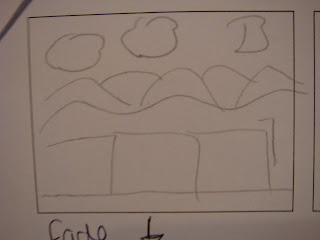
This is an Establishing Shot showing the view from the top of the cliff (one of our chosen locations.)
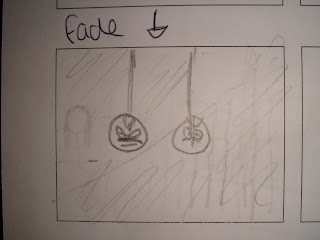
This is a close up tracking shot of the female character's (character A) feet walking on the cliff.
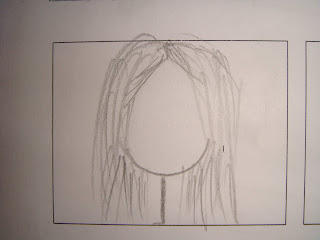
This is a close up of character A's face.
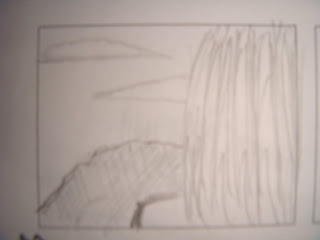
This is an over the shoulder, tracking shot from behind character A.
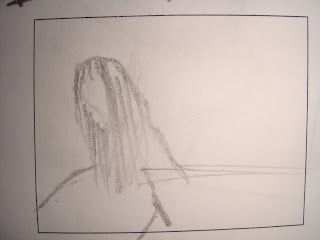
This is a long shot from the side of character A as she looks over the edge of the cliff.
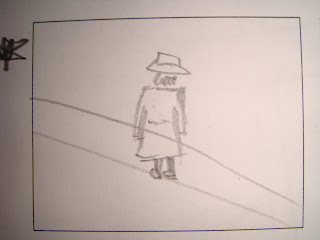
This is a long shot of another character, male (character B), walking through either woods, a cemetery or by a canal.
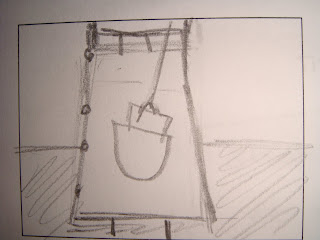
This shows a shot showing character A taking something out of her pocket.
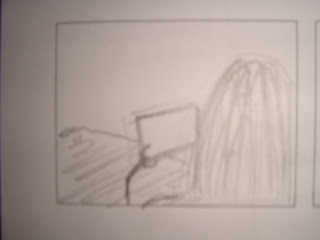
This is a high angle shot from behind character A, showing her looking at a picture.
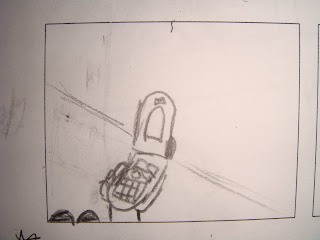
This is a close up, static shot of character B's phone as he rings a number.
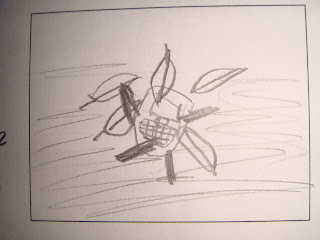
This is a shot of a phone, buried under leaves and twigs, ringing, this would zoom into a close up of the phone so you can see it clearly as it rings.
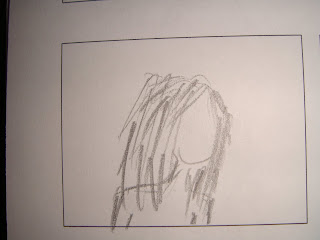
This picture is a mid static shot of the girl turning around because she has heard the phone and the camera would track her as she moves quickly towards it.
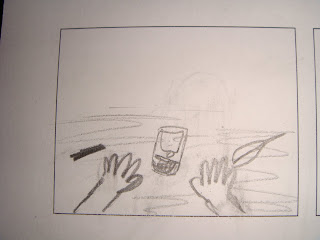
There is then a static shot of her hands rumaging through the leaves and twigs and then it would show her picking up the phone.
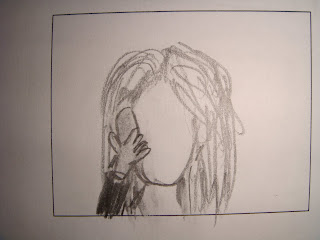
This is a close up of character A's face as she says "Hello?" to see who is on the other side of the call.
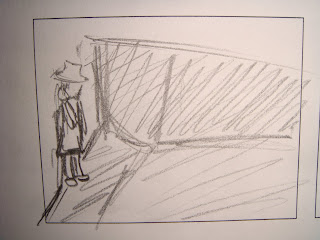
This is a long shot from afar of character B standing against a wall with the phone.
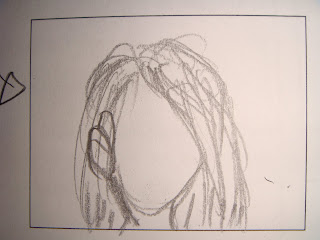
This is another close up of character A saying "Hello?" again, but sounding a bit anxious and a little louder this time as character B did not answer.
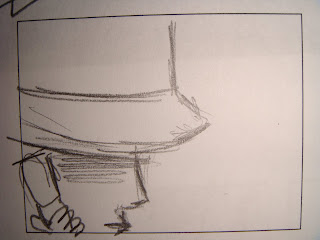
This is an extreme close up of character B as he says "Don't jump." on the phone, then the camera would zoom out and show him taking the phone away from his ear.
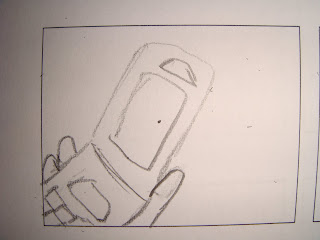
Here is a close up of character B's phone as he hangs up.
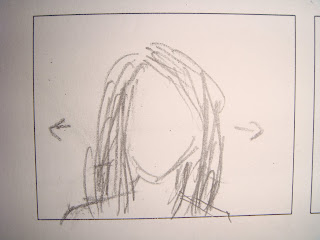
Now a mid static shot of character A, who would look scared, taking the phone away from her ear, shaking and looking around left to right, being paranoid.
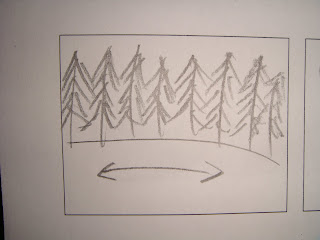
There would then be a quick pan of what she can see in front of her from left to right so we can see what she is seeing.
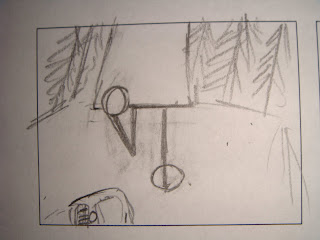
Here is a shot of her dropping her phone and running away from just above ground level so only her legs are seen and as she runs away the background will blur and the sharpest object, in the foreground, would be the phone on the ground.

This is an Establishing Shot showing the view from the top of the cliff (one of our chosen locations.)

This is a close up tracking shot of the female character's (character A) feet walking on the cliff.

This is a close up of character A's face.

This is an over the shoulder, tracking shot from behind character A.

This is a long shot from the side of character A as she looks over the edge of the cliff.

This is a long shot of another character, male (character B), walking through either woods, a cemetery or by a canal.

This shows a shot showing character A taking something out of her pocket.

This is a high angle shot from behind character A, showing her looking at a picture.

This is a close up, static shot of character B's phone as he rings a number.

This is a shot of a phone, buried under leaves and twigs, ringing, this would zoom into a close up of the phone so you can see it clearly as it rings.

This picture is a mid static shot of the girl turning around because she has heard the phone and the camera would track her as she moves quickly towards it.

There is then a static shot of her hands rumaging through the leaves and twigs and then it would show her picking up the phone.

This is a close up of character A's face as she says "Hello?" to see who is on the other side of the call.

This is a long shot from afar of character B standing against a wall with the phone.

This is another close up of character A saying "Hello?" again, but sounding a bit anxious and a little louder this time as character B did not answer.

This is an extreme close up of character B as he says "Don't jump." on the phone, then the camera would zoom out and show him taking the phone away from his ear.

Here is a close up of character B's phone as he hangs up.

Now a mid static shot of character A, who would look scared, taking the phone away from her ear, shaking and looking around left to right, being paranoid.

There would then be a quick pan of what she can see in front of her from left to right so we can see what she is seeing.

Here is a shot of her dropping her phone and running away from just above ground level so only her legs are seen and as she runs away the background will blur and the sharpest object, in the foreground, would be the phone on the ground.
Subscribe to:
Comments (Atom)



